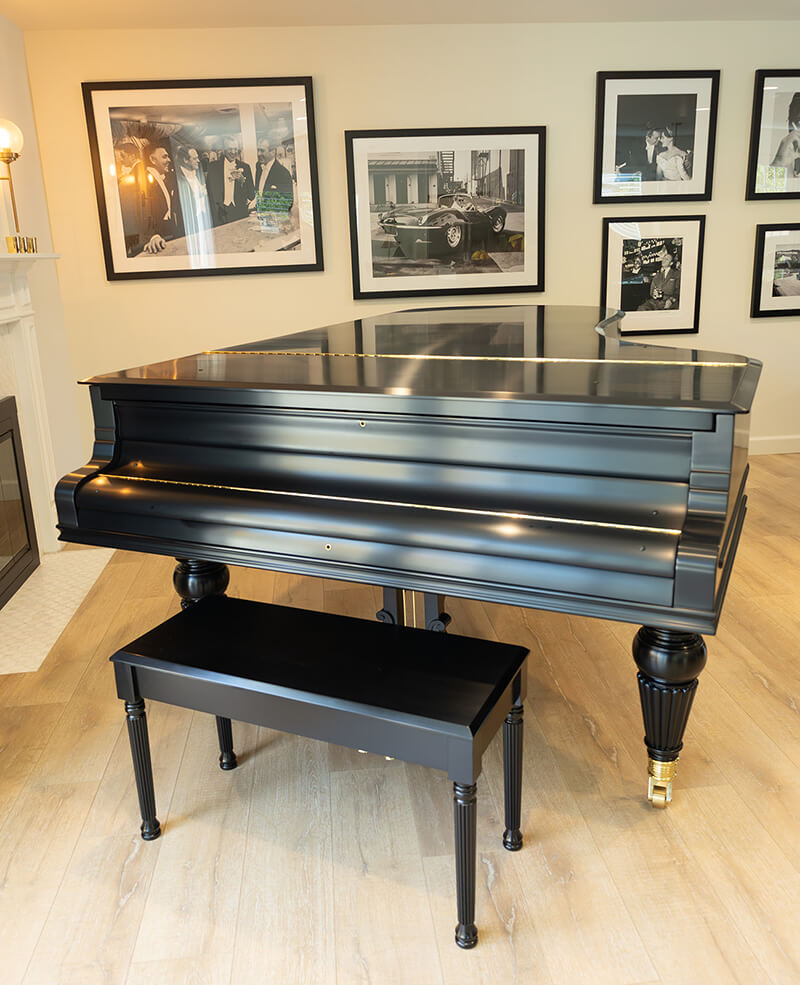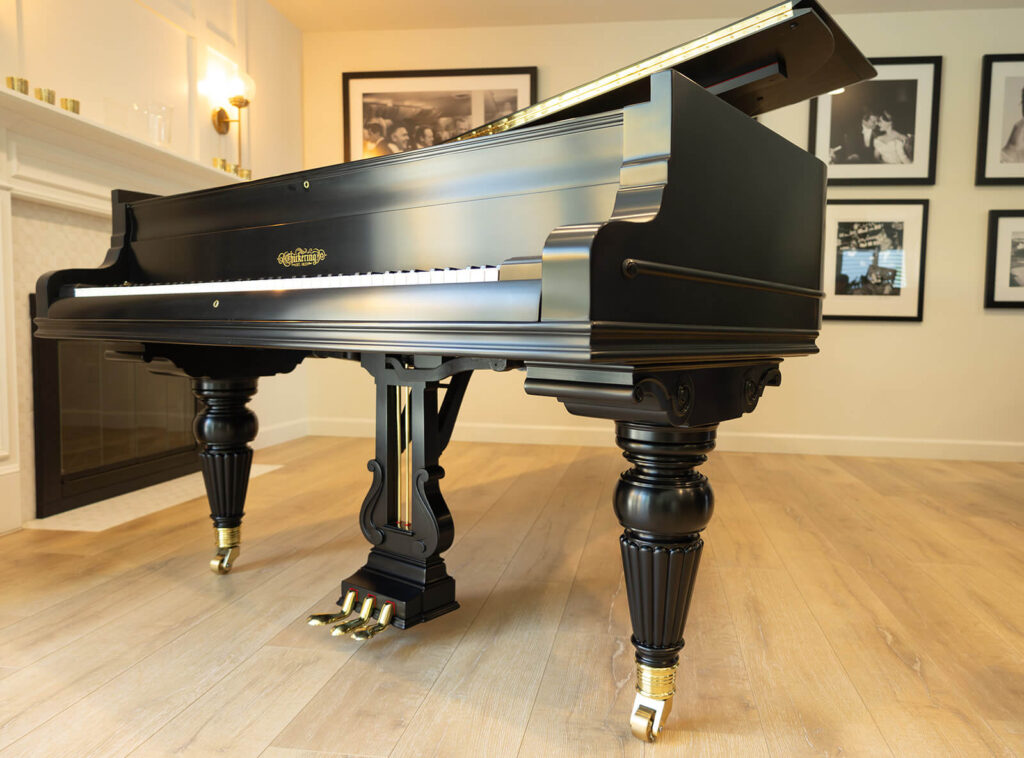Restoration & Appraisal
The ability to create a beautiful tone is paramount when considering a piano renovation, although what catches the eye is more often the cabinetry and the finish. Make sure you assign the task of restoring and refinishing your piano to expert technicians who know how to do the work properly.
Restoring a piano begins with the soundboard, which is the heart of a piano. Your soundboard may need to be replaced, but whenever possible, try to keep the original soundboard. Not only is repairing a soundboard less expensive, but because the wood used to make soundboards on Golden Age pianos came from old growth forests, which do not exist anymore. New growth wood does not perform in the same way, and so replacing a soundboard may not produce a better sounding instrument.
A perfectly restored piano requires restringing. Before this work begins, always have the pin block inspected. Sometimes, you can get a piano to hold its tuning simply by replacing existing tuning pins with larger sized ones. However, the pin blocks on most old pianos are often cracked and must be replaced.
When you have your piano restored, pay close attention to the action and back-action. Chickering parts haven’t been made for decades and the old parts are often worn out. Fortunately, and for the first time since Chickering stopped making parts, there is a company in Japan that has engineered modern action parts, which fit most of the Golden Age Chickering pianos and which preserve the touch and tone. Pacific Piano Supply, which oversaw the restoration of the collection featured on this web site, installed those components with only minor modifications to the action tray. As a result, not only do the pianos sound like they did when they first came out of the Chickering factory, but most piano technicians can adjust and fix them without any problems.
Having access to modern action parts and replacement pieces is a huge advantage. It is strongly recommended that Chickering owners have this work done to ensure that their pianos can optimally function for the next 100 years.

Ivory is no longer used on keys but if you have a nice set of ivory keys, keep them. A good restorer will have some spare ivories to replace a limited number of broken or chipped ones. However, if most of your piano’s ivory keys are not in good shape, have the restorer replace them with a high-quality synthetic material. Whether ivory or synthetic, keys should be adjusted to ensure they have the right touch.
To complete a thorough restoration, the refinishers must completely disassemble the piano and remove all the hardware. Hardware is sent off to a metal shop for cleaning, polishing, and replating, while refinishers coat the wooden parts with a chemical stripper to remove all the varnish and stain. Once they reach the wood veneer, the refinisher begins repairs. They should fill holes, replace broken or missing veneer, re-glue loose and open joints, and refabricate any missing sections. The final preparation step involved sanding until all surfaces are perfectly smooth. If the piano originally had defined, sharp edges, a good refinisher will take care to maintain those and not round them by over sanding.
Pianos are then covered with a wood-colored stain. Most piano finishes do not show the texture of the wood grain. If you do not want a woodgrain feel, the refinisher will need to use a sealer to fill all the pores and ensure that the surface is completely smooth. For a black or ebony effect, after the sealer cures, the refinishers coat the piano repeatedly with black lacquer, buffing the finish after each coat. For a piano that shows the wood grain, a clear coat goes on instead. If you want a matte or hand-rubbed finish, the refinishers will carefully scratch the surface by rubbing the piano in a single direction with an exceptionally fine grade of steel wool after the last coat of finish is applied and cured.
Chickering Pianos before and during the Golden Age were stained so that the beautiful mahogany or rosewood veneers could be seen. If you want to be historically correct, and you have a piano that dates to the Golden Age or earlier, show the wood grain with a medium or medium-dark stain when you have your piano refinished.
Lastly, refinishers put the polished hardware back and then reassemble all the pieces.
What is my Chickering Piano worth?
Condition is the biggest factor in determining a piano’s value. Piano technicians are best equipped to determine a piano’s condition. They will charge between $100 and $200 to inspect a piano and provide a written report.
Chickering pianos aren’t manufactured anymore, so there is no such thing as a new Chickering Parlor Grand to compare to the new Steinway, but there are recently rebuilt Chickering pianos that have been restored to factory-new condition. Those instruments sell for between $25,000 and $35,000, or roughly half of a recently restored Steinway’s price. A restored Chickering would appeal to a diverse group of people, including interior designers who appreciate the look of the cabinetry and jazz artists who like the warm, woody tones that these pianos produce.
A 6½’ Chickering Parlor Grand in excellent condition that had not been restored recently is worth between $5,000 to $10,000. These pianos are a good alternative to the inexpensive Asian pianos, in large part because the tone from a Chickering is usually richer sounding. An older Chickering Parlor Grand with a less-than-perfect finish but otherwise in good condition can make a fine student piano, and it would be worth between $1,000 and $3,000. To command that value, all the keys must work, the sound must still function properly and the piano has to hold its tuning for a reasonable amount of time.
The value of Chickering Concert and Semi-Concert Grands would be somewhat higher than Parlor Grands because of size. However, these larger pianos were originally built for concert halls and concert halls aren’t generally in the market for older, used pianos. Because most residences don’t have room to accommodate such large instruments, there are only a limited number of buyers. On the other hand, the value of Chickering Quarter and Baby Grands would be equivalent to the value of a Parlor Grand despite the smaller size. More people have room for a smaller piano, so the demand for those smaller instruments is greater.
Unfortunately, a huge number of Chickering pianos are 75 years old or older and have reached the end of their productive lives. If a Chickering piano no longer holds a tuning for very long, if some of the keys don’t work anymore, and if a technician can’t fix the problem for a reasonable amount of money, then the piano can no longer be considered a musical instrument. Such a piano has a value approaching $0. When a piano with these challenges comes to the end of its life, it is destined for one of two places: a rebuilder’s shop or the junkyard.
